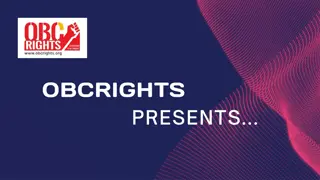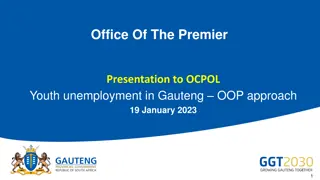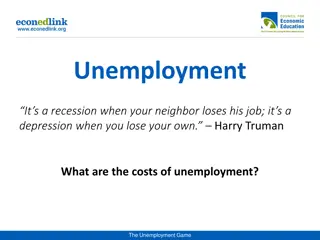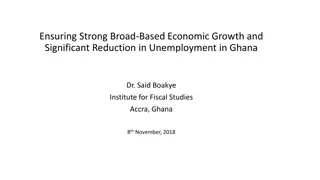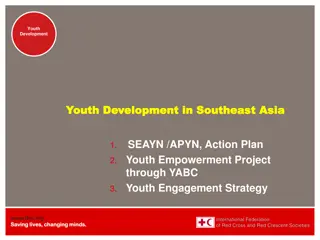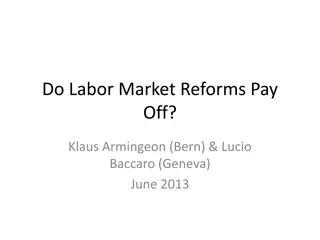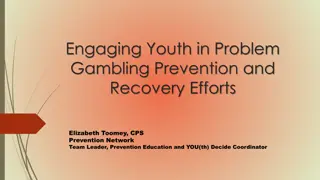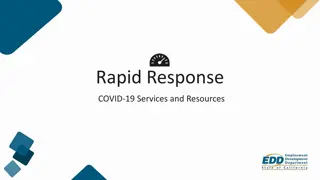Addressing Youth Unemployment: Strategies and Policy Measures
Global statistics on youth unemployment highlight the severity of the issue, emphasizing the need for targeted policy intervention. Bahrain's low unemployment rate is contrasted with the global trend. The consequences of youth unemployment are discussed, along with recommended policy areas and measures for tackling the crisis.
Download Presentation

Please find below an Image/Link to download the presentation.
The content on the website is provided AS IS for your information and personal use only. It may not be sold, licensed, or shared on other websites without obtaining consent from the author. Download presentation by click this link. If you encounter any issues during the download, it is possible that the publisher has removed the file from their server.
E N D
Presentation Transcript
ITU Arab Regional Development Forum (Manama, Kingdom of Bahrain) S2: The Development of ICT for Job Creation Your Development for the career you wish Khalid AlQoud www.khalidalqoud.com
Today Facts 75 million young people are unemployed worldwide Globally young people are on average nearly three times more likely than adults to be unemployed Four out of every ten unemployed worldwide is a young women or man Over 1.2 billion people in the world between 15 and 24 years of age 40 % of the world's unemployed are young people Source: ILO, Trends Econometric Models, February 2013.
Global youth unemployment and unemployment rate, 1991-2013 Source: ILO, Trends Econometric Models, February 2013.
Bahrain has unemployment rate which remained as low as 3.8 % with the number of jobless people going down from 7222 in October to 6788 in December 2012. Mostly Young People
Consequences of youth unemployment Is likely to become more serious the longer youth unemployment crisis continues Raise risk of future unemployment and/or protracted period of unstable employment Valuable work experience is not acquired and professional skills may erode Effects more severe for youth entering the workforce with education level below university level Is likely to result in wage scars that continue to depress employment and earnings prospects Youth are increasingly employed in non-standard jobs, including temporary employment and part-time work
We should focuses on five policy areas 1. employment and economic policies to increase aggregate demand and improve access to finance; 2. education and training to ease the school-to-work transition; 3. labour market policies to target employment of disadvantaged youth; 4. entrepreneurship and self-employment to assist potential young entrepreneurs; and 5. labour rights that are based on international labour standards to ensure that young people receive equal treatment.
Policiy measures What works for youth? Comprehensive packages of labour market measures targeting specific groups of young people Balanced strategies for growth and job creation Platforms for exchanging knowledge and lessons of what works Apprenticeships, skills training and other work-training programmes Multiple services for entrepreneurship, social enterprises and cooperatives Targeted youth employment action through a time action plans development Business Start-up Bank loans for youth Employment services
Its not the role of government everyone has a role to play Young people Parents, carers and families The media Businesses Teachers Youth workers Other professionals Local authorities Societies Government
What this means for local authorities We should build What this means for YP Services for young people support key outcomes A positive place for YP A stronger voice Support for families New guidance to clarify expectations Community responsibility Early help to succeed Integration Young people must have a voice New opportunities Effective early help Open markets A more positive place in society Responsibility to improve Innovative Space
What this means to YOU What this means for voluntary organisations What this means for business Government is tackling youth unemployment Recognition of role in lives of YP YOU A responsibility to help YP play positive role in society ARE A stronger voice Business case for supporting youth organisations More open public services THE Opportunities for engagement Opportunities for innovation and growth CHANGE
To address youth unemployment 1. 2. 3. 4. Employability Equal opportunities Entrepreneurship Employment creation policy investing in education for men and women start and run businesses as part of macroeconomic 4E s
The future needs Local and regional action plans for youth employment. Mobilizing financial resources for youth employment Linking youth employment with education Expanding on youth participation in policy and action: No decision making without youth participating
Lets start The Youth Employment Network (YEN)

 undefined
undefined







